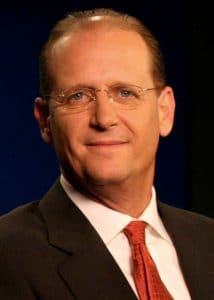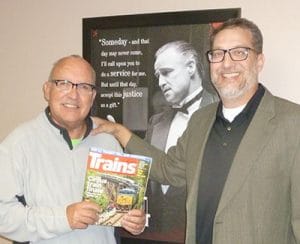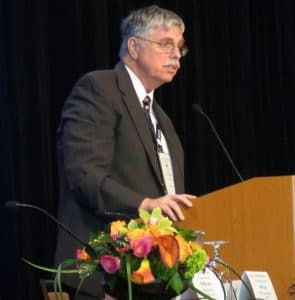A U.S. senator from Kansas received an assurance in a letter from Amtrak’s president and CEO that the national passenger carrier will maintain long-distance service at its current status quo through the 2019 fiscal year, which ends Sept. 30, and possibly on through the enactment period of the Fixing America’s Surface Transportation (FAST) Act, which runs through the 2020 fiscal year.
However, U.S. Sen. Jerry Moran’s delay on the consideration by the U.S. Senate of three presidential nominees to the Amtrak Board of Directors, which he started in early May, appears that it will continue.
Kansas News Service (ksnewsservice.org) reported that a spokesperson for the senator said a May 22 in-person meeting between Moran and Anderson was a “step in the right direction.” However, the holds Moran placed on President Donald Trump’s nominations to the Amtrak Board of Directors will remain while he awaits more answers to questions that arose from that meeting, the report said.
Moran is particularly concerned about the long-term future of the daily Chicago-to-Los Angeles Southwest Chief route. Last year, U.S. senators had to pressure the carrier to continue the route, which serves many rural areas, through the 2019 fiscal year.
Amtrak’s top boss, Richard Anderson, wrote in a letter to Moran that congressional action has secured the short-term future of the long-distance routes.
“We believe that Congress generally endorsed continued operation of our current route network for the five-year period from FY15-FY20 through the enactment of the Fixing America’s Surface Transportation (FAST) Act,” Anderson wrote. “Thus, although Amtrak is not technically required to operate any given route under the FAST Act, we plan on operating all of our long-distance trains for the remainder of this period while seeking to drive improved performance consistent with our goal to grow ridership while reducing Federal subsidies.”
However, Anderson also indicated that alterations to the long-distance interstate service again will be considered as the carrier seeks to build upon its recent performance, with increased ridership and record-setting fiscal performance with higher revenue and reduced operating losses.
“… We must position ourselves to attract a new generation of customers. Just as other modes of transportation and businesses are compelled to evolve, so must we if our mode is to grow as a relevant and efficient means of mass transportation,” Anderson wrote. “We owe this to our customers and your constituents, along with our nearly 20,000 hard-working and dedicated employees. That is why we have a plan to break even on operating results by 2020.”
Anderson went into detail about the financial performance and cost of the carrier’s long-distance routes and said more than half of the federal appropriations that Amtrak received went toward funding those routes.
“Long-distance trains require large federal subsidies because their revenues are lower and operating costs are higher than Amtrak’s state-supported and NEC (Northeast Corridor) services. The federal government is virtually the only funding source for the capital investments they require,” Anderson wrote. “These costs are set to increase significantly in the future as we face host railroad-related poor on-time performance across the network and much of our equipment used in long distance service reaches the end of its useful life and requires replacement.”
Discussion of an upcoming funding reauthorization in Congress will give a clearer indication of the future of the long-distance routes, Anderson said.
“Looking forward, we aim to have a conversation with Congress and our other stakeholders about the future of the long-distance services,” Anderson wrote. “While we strongly believe that there is a permanent place for high quality long-distance trains in our network, the time to closely examine the size and nature of that role is upon us for numerous reasons.”
The replacement of long-distance routes with new corridor service is certainly on the table for Amtrak, Anderson said. Among potential corridors warranting further study are Mobile, Alabama to New Orleans; Fort Worth, Texas to Newton, Kansas; Minneapolis and St. Paul, Minnesota to Chicago and Duluth, and the Front Range Corridor.
An initial analysis of these potential corridor routes is expected to be performed this summer, he wrote.
“Demand for shorter rail trips in corridors between major cities is increasing, particularly in the fast-growing South, Southwest and Mountain states,” Anderson wrote. “However, the minimal service Amtrak currently provides in these regions, with long-distance trains that are often many hours late and serve major cities in the middle of the night, does not meet the needs of their rapidly increasing populations.”
Follow this link to read Anderson’s full letter to the senator.
The three nominees whose nominations have been placed on hold by Moran are Rick Dearborn, Joseph Gruters and former U.S. Rep. Lynn Westmoreland. SMART TD opposes Westmoreland’s nomination.
Tag: Amtrak
At a meeting last week involving Metra and suburban Chicago city leaders, U.S. Rep. Dan Lipinski, chairman of the U.S. House Subcommittee on Railroads, Pipelines and Hazardous Materials, told the carrier that it needed to step up its performance.
“Too often, Metra riders are not getting the service that they deserve,” Lipinski said in a news release. “I said in a town hall I held in December to address problems on the BNSF line that 2019 needs to be a better year for all Metra riders. Metra is still coming up frustratingly short. It is time to stop passing the buck and find solutions.”
Metra struggled with a technology outage involving Amtrak at Union Station in February, which prompted the April 16 meeting, according to the Joliet Herald News.
Read the full story in the Herald News.
Read Lipinski’s news release.
U.S. Senator Jon Tester (D – Mont.) recently criticized the Trump administration for budget proposals that would cut funding for Amtrak rural services, especially the Montana Empire Builder line, and wrote Amtrak’s President Richard Anderson asking for accountability and answers.
“Congress purposely created a national network of long-distance and state-supported train service throughout the nation, in recognition of the importance of a transportation system that reaches every community — regardless of how rural it may be. Amtrak is more than a collection of individual train routes: it is a web of essential connections that bind our country together and link rural communities with major markets and economic opportunities. It provides residents of these communities with transportation options on which families, seniors, and businesses rely to access jobs, create economic opportunities, see our beautiful country. and visit family,” Tester’s letter to Anderson stated. “The federal investment in Amtrak ensures the small, mid-size, and rural communities served by Amtrak’s long-distance and state-supported routes continue to receive this essential service.”
Tester also posed the question to Amtrak as to why ticket agents have been eliminated and questioned the accounting methods the carrier is using to determine the cost of long-distance services. He also questioned leadership’s claims that long-distance service is down despite 2017 figures that showed that ridership is up 10.6% from the previous eight years. He asked that Amtrak address his questions by no later than April 29.
Sen. Tester’s bipartisan letter includes signatures from 10 other senators, including Tom Udall, Michael Bennet, Pat Roberts, Cory Gardner, Jerry Moran, Catherine Cortez Masto, Martin Heinrich, Joe Manchin III, Dick Durbin and Kyrsten Sinema.
In other news, Amtrak’s Hoosier State line also is on the chopping block due to Indiana backing out on funding for the 196-mile Amtrak route. The carrier has stopped ticket sales for the Chicago-to-Indianapolis Hoosier State line after July 1.
Click here to read Sen. Tester’s letter to Amtrak.
The National Transportation Safety Board (NTSB) ruled last month on the probable cause of a fatal accident in June 2017 that killed both a CSX conductor and a conductor trainee.
The men were struck from behind at 11:18 p.m. June 27, 2017, by an Amtrak train while walking to the cab of their train in Ivy City, a neighborhood in Washington, D.C.
The men had just completed a railcar inspection.
The NTSB report, released April 9, stated that there had been no rail traffic for about an hour on the active tracks upon which the men were walking as they returned.
As they walked, a pair of Amtrak trains, one northbound and one southbound, approached the men, the report stated.
NTSB said the northbound Amtrak train approached the men from the front on tracks to the left of those upon which they were walking, and that both trains sounded their horns and bells at virtually the same time in attempts to alert them.
“Given the simultaneous and similar horn and bell sounds from the two trains, the conductors may not have discerned two sources of the sounds and, consequently, concluded that the sounds originated from only one train — the one that they had detected ahead of them.
“As a result, it appears the conductors were unaware that a second train was approaching them from behind,” the report stated.
NTSB issued a new safety recommendation to the two carriers involved in the accident at the conclusion of its report:
“Prohibit employees from fouling adjacent tracks of another railroad unless the employees are provided protection from trains and/or equipment on the adjacent tracks by means of communication between the two railroads.”
Read the full NTSB report here.
Amtrak as we know it is in the budget crosshairs again, and if proposed cuts go through, it could have a lasting effect on not only our nation’s communities, but Railroad Retirement benefits as well.
President Donald Trump’s budget request proposes a $1.06 billion reduction in funding to Amtrak. Service to rural and mid-sized city destinations would be drastically affected with the adoption of this plan, and 15 routes classified as long distance could eventually lose federal funding due to a change in how funds are allocated.
“We hope that, like last year, this budget is a non-starter,” said Jim Mathews, president and CEO of the Rail Passengers Association (RPA). “But we note with some concern that this time around, the administration appears to be getting a little smarter in its approach — and that approach could yet endanger our trains.”
Rather than cutting the routes outright, as has been proposed in previous Trump budgets, the 2020 plan would shift the money available to fund long-distance routes from Amtrak’s annual outlay to a competitive process. Over a four-year period, the administration would choose the routes that received funds with states applying for funding through the Restoration & Enhancement grant program.
“The Trump Administration seems to be taking a page from anti-long-distance factions in Washington, looking to pit National Network services against the Northeast Corridor. And by moving it to a competitive grant program — controlled by the White House — the administration gets to choose the winners and losers,” Mathews said.
The plan doesn’t sit well with the RPA’s Mathews, and it shouldn’t sit well with SMART Transportation Division rail members. Reducing Amtrak’s long-distance service will result in fewer people at work for the carrier. Fewer people working for the carrier means fewer railroaders paying into Railroad Retirement — a Railroad Retirement Board analysis of Trump’s 2018 budget proposal that would have cut Amtrak’s long-distance routes said an estimated 10,000 rail jobs would go away with the routes’ elimination.
For long-distance rail service to continue, the 2020 budget document suggests that the 23 states that the routes run through begin footing the bill rather than the federal government, which handed many corporations a major tax reduction at the end of 2017.
“In 2020, the Department of Transportation, Amtrak, states, and affected local Governments will collaborate to rationalize the Long Distance network to more efficiently serve modern market needs as a series of shorter-distance, high-performing corridor services where passenger rail as a transportation options (sic) makes sense,” the 2020 budget proposal states on page 78.
The budget goes on to say that “low population areas along the routes will be better served by other modes of transportation, like intercity buses.
“Over time, Federal support for Amtrak would be significantly reduced as Amtrak is able to right-size its network and States play a larger role, as they do now for State-supported and Northeast Corridor services,” the budget proposal concludes.
Hoosier State on the brink
But what happens to smaller places like Indiana, where routes are already in jeopardy?
Mayor Dennis Buckley’s city of Beech Grove is home to one of three Amtrak repair facilities nationwide. The Indianapolis-area shop employs approximately 525 workers and is served by Amtrak’s Hoosier State line that transports passengers from Indianapolis to Chicago as well as Amtrak cars to the Beech Grove facility for repairs.
The state’s Legislature and the governor are looking to defund the route, Buckley said, and he finds himself having to fight for the jobs created by both Amtrak and by the businesses that have sprung up around the repair facility in his city of almost 15,000 people.
In a letter to state legislators urging them to support the route, Buckley said that Amtrak brings $100 million to the economy of central Indiana and Beech Grove’s Marion County.
“Amtrak must also become more competitive in the business of local mass transit,” Buckley said, but eliminating the four-stop, 196-mile route would be a severe blow to his community.
“Budgets should be set up to continually fund the Hoosier State line for years to come,” Buckley wrote to legislators, “I certainly recommend that the State of Indiana invests in our future. Our livelihood depends on it.”
As part of his effort, Buckley has reached out to Indianapolis media outlets. He would welcome it if SMART TD members who are Indiana residents talk to their legislators and state Gov. Eric Holcomb about maintaining the route’s funding.
Repeat performance
The targeting of Amtrak’s long-distance routes is not new.
In addition to the administration’s yearly call to eliminate long-distance service, there was a battle waged last year over the Southwest Chief. Amtrak leadership had sought to replace portions of the route between Dodge City, Kan., to Albuquerque, N.M., with bus shuttles because of a lack of Positive Train Control (PTC) technology.
Communities on the Chicago-to-Los Angeles daily route mobilized, and the activism of workers, passenger rail advocates, politicians and others preserved the route’s funding and operation as-is through 2019.
Similar action might be needed yet again to prevent any proposed harmful cuts to Amtrak’s long-distance routes as the federal budgeting process continues. SMART Transportation Division will keep members apprised.
To find out who represents you in Congress, visit the SMART TD Legislative Action Center.
National passenger carrier Amtrak released its 2018 Host Railroad Report Card, which grades six of the Class I freight host railroads based on delays caused to Amtrak trains over the last 12 months.
The grades ranged from A to F, with Canadian Pacific being the lone recipient of an “A.” Norfolk Southern got an “F.”
All told, Amtrak averaged the overall performance of the Class I host railroads at a “C.”
Eleven of 28 Amtrak state-hosted routes achieved 80 percent on-time performance (within 15 minutes of scheduled departure), according to the report card.
Conversely, only one of the 15 long-distance routes, the “Auto Train,” had on-time performance of more than 70 percent, Amtrak said.
See the full report card (PDF) by following this link.
Amtrak announced today that former President and CEO Joseph Boardman, 70, died today after having a stroke March 5:
“We are deeply saddened to learn of the passing of Joe Boardman.”
“Joe, during his tenure as FRA administrator, Amtrak board member and Amtrak president & CEO, was a tireless advocate for passenger rail and the nation’s mobility. During his eight years at the helm, Joe helped the company make significant progress in reducing our debt, improving our infrastructure and raising our cost recovery performance.”
“He leaves a lasting legacy that includes public service and making passenger rail transportation better for millions of people.”
Click here to read tributes from Trains Magazine and Railway Age.
Relatives and friends may call at the Barry Funeral Home, 807 W. Chestnut St., Rome, NY 13440 on Thursday, March 14 from 2 to 4 p.m. and from 6 to 8 p.m. A Mass of Christian Burial will take place at 11 a.m. on Friday, March 15 at St. Paul’s Church, 1807 Bedford St., Rome, NY 13440. Interment will be at St. Patrick’s Cemetery, Route 285, Taberg, NY 13471 and will take place in the spring.
In lieu of flowers, contributions may be made in Boardman’s memory to Unity Acres, 2290 County Route 2, P.O. Box 153, Orwell, NY 13426; Health Friends, 1119 Elm St., Utica, NY 13501; or to the Epilepsy Foundation.
To read Boardman’s official obituary or to leave condolences, click here.
A number of candidates to transportation-related oversight posts in the federal government whose nominations were returned to President Donald Trump in early January have been renominated to those posts.
Thelma Drake has been renominated to be the administrator of the DOT’s Federal Transit Administration (FTA) and Lynn Westmoreland, Joseph Gruters and Rick Dearborn are again under consideration for positions on the Amtrak board of directors.
SMART Transportation Division opposes the nomination of Westmoreland, whose voting record as a U.S. representative shows he has a long history of voting against Amtrak funding.
“As a longtime member of the House Transportation and Infrastructure Subcommittee on Railroads, Pipelines, and Hazardous Materials, Westmoreland has a hostile voting record against Amtrak, which includes efforts to eliminate federal funding for Amtrak entirely. In addition, Westmoreland has been an original cosponsor of the ‘National Right-to-Work Act’ on multiple occasions, which would significantly weaken our ability to collectively bargain. For these reasons, we oppose his nomination as it would undermine the core mission of Amtrak and its employees,” we reported when his nomination was initially introduced in October 2017.
Also renominated by the president are Michelle Schultz to the Surface Transportation Board (STB), and Michael Graham and Jennifer Homendy to the National Transportation Safety Board (NTSB). Homendy is currently serving a term on the board that runs out at the end of 2019.
Two nominations also were made to highway oversight positions — Heidi King to administer the National Highway Safety Administration (NHTSA) and Nicole Nason to administer the Federal Highway Administration (FHA).
These nominations will be considered by U.S. Senate subcommittees before potential advancement for consideration by the full Senate.
A feed company whose truck rolled down a hill and crashed into railroad tracks in Cimarron, Kan., in March 2016 has admitted fault and avoided a trial on the matter.

Amtrak’s Southwest Chief derailed on those same tracks about 15 hours later, and 28 people aboard the Los Angeles-to-Chicago train were hurt.
The Associated Press reported that Cimarron Crossing Feeders said in a court filing that an employee was negligent in not setting the truck’s brake, allowing it to roll.
The National Transportation Safety Board determined last November that the probable cause of the derailment was that driver’s failure to properly secure his unattended truck, which struck the BNSF railroad tracks and caused them to misalign.
NTSB also ruled the failure of the truck’s driver and his supervisor to report the incident to local authorities was a contributing cause in the accident.
During a Senate Commerce, Science and Transportation committee hearing on the implementation of positive train control (PTC) among U.S. railroads Oct. 3, an Amtrak executive said that the carrier plans to continue operating the Southwest Chief passenger route through at least the 2019 fiscal year.
Amtrak Vice President and Chief Operating Officer Scot Naparstek told U.S. Sen. Tom Udall (D) of New Mexico that the route, which various reports had said would get a 500-mile “bus bridge” from Dodge City, Kan., to Albuquerque, N.M., to avoid non-PTC trackage, would be operated as usual once the Dec. 31, 2018, PTC deadline passes.
Senators representing areas with stops on the route, including Udall, as well as rail passenger advocacy groups had been fighting this option.
“We plan on running the Southwest Chief as-is through fiscal year 2019. We are well aware of the Senate’s directive,” Naparstek said. “We await Congress’s dealing with the Southwest Chief during the (budget) conference as well as in the fiscal spending bill.”
The president of the Rail Passengers Association was pleased with the outcome.
“This is a huge win for our association, for passengers, and for the states that rely on the Southwest Chief,” said Rail Passengers Association President Jim Mathews. “It shows that advocacy works, and I want to thank every person who took part in our campaign in defense of the national network. Now, we need to take that energy and turn it towards the coming reauthorization where we can make a positive vision for passenger rail in the U.S.: fast and frequent trains, 21st century equipment, and on-time service that passengers can count on.”
The Southwest Chief runs daily from Chicago to Los Angeles.



